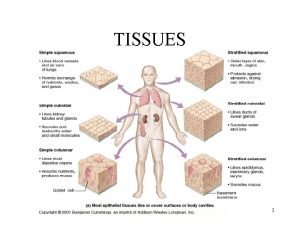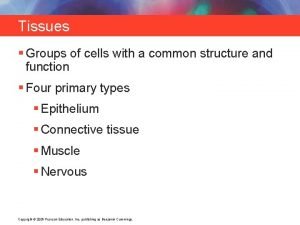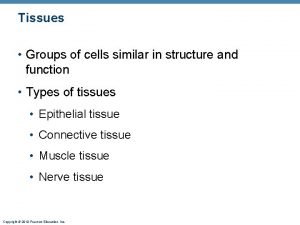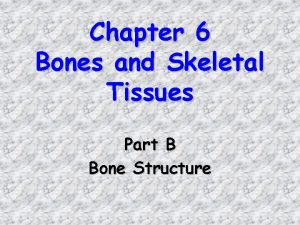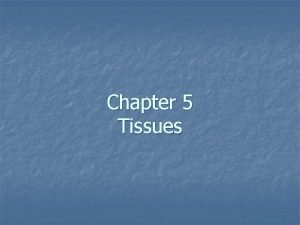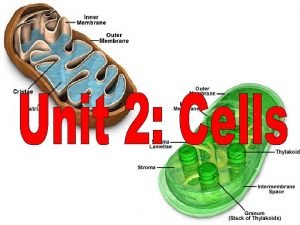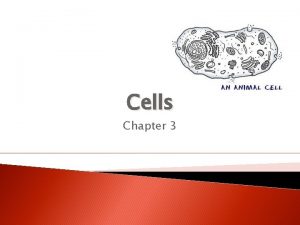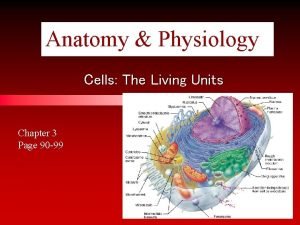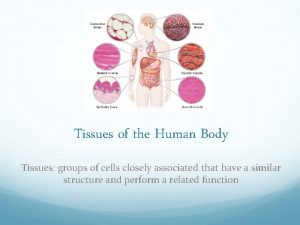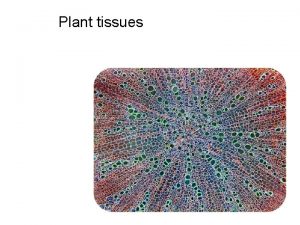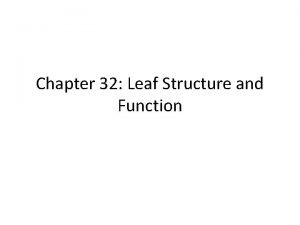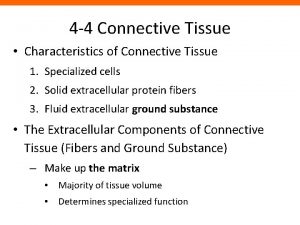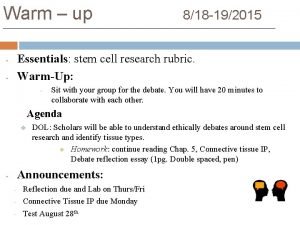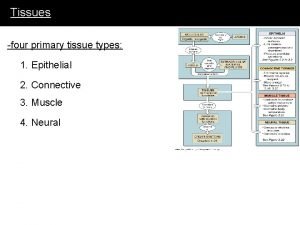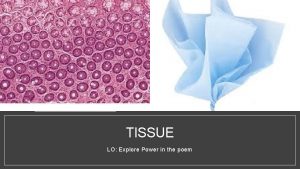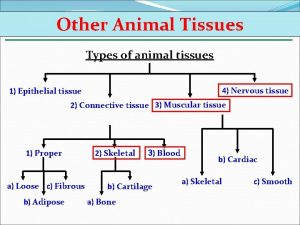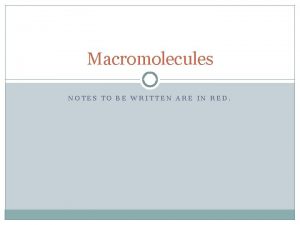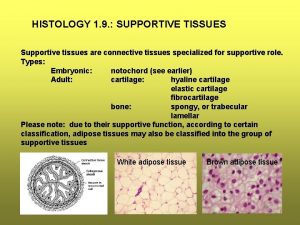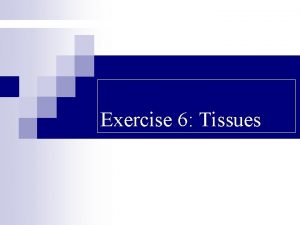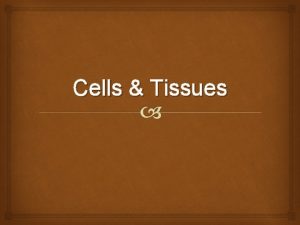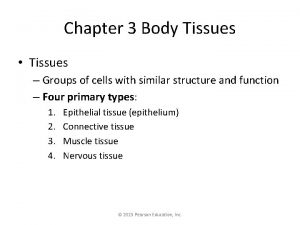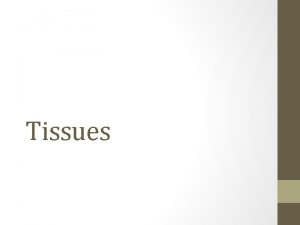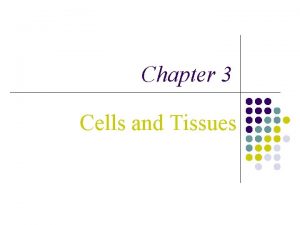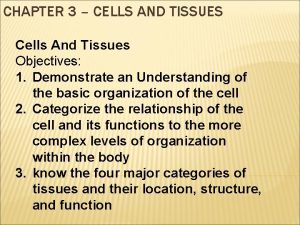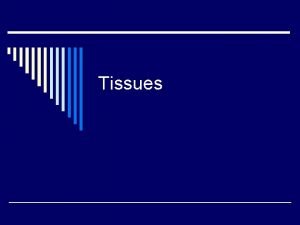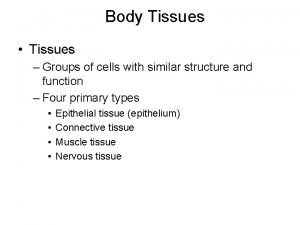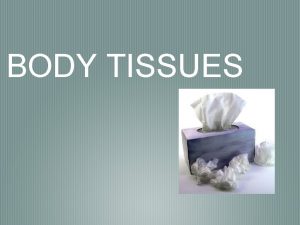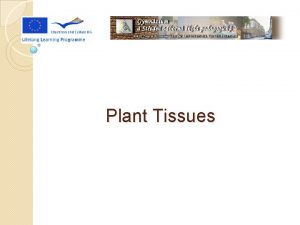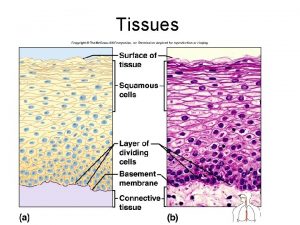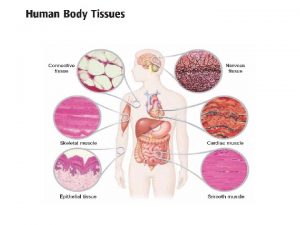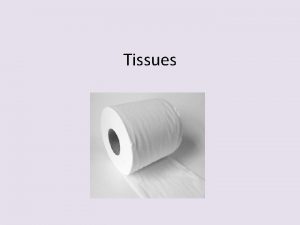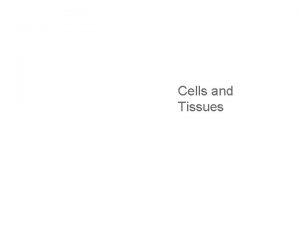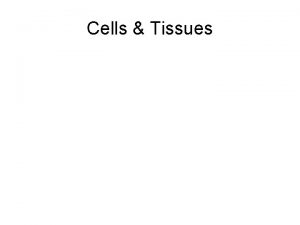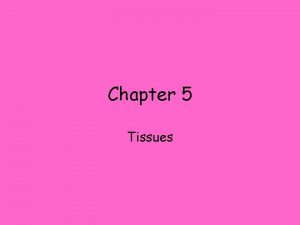Tissues Chapter 4 Tissues groups of cells with
































































- Slides: 64

Tissues Chapter 4

Tissues � groups of cells with common role � 4 basic types: � Epithelial � Connective � Muscular � Nervous

Epithelial Tissue �Cells close together – continuous sheets �Cover surfaces & line cavities- always a free surface =Apical surface �Basement membrane of connective tissue �No blood vessels- avascular �Have a nerve supply � High capacity for cell division.

Categories- Table 4. 1 � Simple epithelium = ◦ 1 layer of cells � Stratified Epithelium= ◦ more than 1 layer of cells � Cell Shapes = ◦ squamous, cuboidal, columnar, transitional (change shape)

Simple Epithelium � Squamous= single layer of flat cells. � Important for filtration (kidneys) or diffusion (lungs & capillaries) � Called endothelium when lining heart, blood and lymphatic vessels � Called mesothelium when in serous membranes

Simple Squamous Epithelium single layer of flat cells

Simple Squamous Epithelium single layer of flat cells

Simple Squamous Epithelium single layer of flat cells

Simple Cuboidal Epithelium cube shaped cells, rounded nuclei

Simple Cuboidal Epithelium cube shaped cells, rounded nuclei

Simple Columnar Epithelium May be ciliated or non-ciliated

Simple Columnar Epithelium May be ciliated or non-ciliated

Simple Columnar Epithelium May be ciliated or non-ciliated

Simple Columnar Epithelium May be ciliated or non-ciliated

Pseudostratified Columnar appears stratified: nuclei at various levels

Pseudostratified Columnar appears stratified: nuclei at various levels

Stratified Squamous Epithelium � Apical layer cells are flat � Deep layers vary from cuboidal to columnar � Cells in the basal layer divide and move upward toward apical surface � Found in areas of surface wear & tear

Table 4. 1 f figure 1

Table 4. 1 f figure 2

Stratified Cuboidal Epithelium rare

Stratified Cuboidal Epithelium rare

Stratified Columnar Epithelium rare

Stratified Columnar Epithelium rare

Transitional Epithelium variable in appearance—cells can stretch

Transitional Epithelium variable in appearance—cells can stretch

Glandular Epithelium-Endocrine

Glandular Epithelium-Endocrine

Glandular Epithelium-Endocrine

Glandular Epithelium-Endocrine

Connective Tissue � Most abundant tissue type � small cells far apart � large amount of extracellular material (matrix) � Often good blood supply �Found between other tissues � Classified using matrix characteristics

Connective Tissue Cells vary with tissue type � Fibroblasts- present in several tissues ◦ secrete fibers & ground substance � Macrophages- from monocytes ◦ Engulf bacteria & cell debris by phagocytosis � Plasma cells- develop from B lymphocytes ◦ Make antibodies

Connective Tissue Cells � Mast cells- near blood cells ◦ part of reaction to injury- histamine � Adipocytes= fat cells or adipose cells ◦ Store triglycerides (fat)

Extracellular Matrix �Fluid, gel or solid plus protein fibers �Ground substance-between cells and fibers �Fibers- 3 types �Collagen fibers: very strong & flexible �Elastic fibers: smaller stretch and return to original length �Reticular fibers: provide support & strength ◦ found in basement membranes & organ support

Figure 4. 2

Loose Connective Tissue � Areolar � Adipose � Reticular

Table 4. 2 a figure 1

Table 4. 2 a figure 2

Table 4. 2 b figure 1

Table 4. 2 b figure 2

Table 4. 2 c figure 1

Table 4. 2 c figure 2

Classification � Dense Connective tissue ◦ Dense regular ◦ Dense irregular ◦ Elastic

Table 4. 2 d figure 1

Table 4. 2 d figure 2

Table 4. 2 e figure 1

Table 4. 2 e figure 2

Table 4. 2 f figure 1

Table 4. 2 f figure 2

Cartilage �Dense network of collagen & elastic fibers embedded in chondroitin sulfate �stronger than dense fibrous �Cells = chondrocytes �Occur singly or in groups �Found in spaces called lacunae �Surrounded by perichondrium �No blood vessels or nerves

Classification - Cartilage � 3 types � Hyaline- fibers not easily visible � Fibrocartilage- fibers visible � Strongest type. E. g. in vertebral discs � Elastic- chondrocytes in threadlike network e. g. ear cartilage

Table 4. 2 g figure 1

Table 4. 2 g figure 2

Table 4. 2 h figure 1

Table 4. 2 h figure 2

Table 4. 2 i figure 1

Table 4. 2 i figure 2

Bone = Osseous Tissue � More dense matrix includes Calcium & phosphorus salts � Details in Chapter 6

Liquid Connective Tissue � Blood- matrix = plasma ◦ More in chapter 14 � Lymph- matrix like blood but with less protein ◦ More in chapter 17

Muscular Tissue �large, elongated cells �contractile cells �Skeletal muscle tissue -named for location �Cardiac muscle tissue- forms wall of heart �Smooth muscle tissue –found in walls of hollow organs

Neural Tissue � Nerve cells & neuroglia � Neurons- convert stimuli into nerve impulses and conduct them � Neuroglia –do not generate nerve impulses. � Serve supportive functions

Body Membranes � 3 types of body (not cell) membranes �Mucous Membranes –line body cavities opening to exterior ◦ Secrete mucus �Serous organs Membranes- surround moving ◦ Secrete serous fluid �Synovial Membranes- line cavities of some joints. ◦ Secrete synovial fluid

Tissue Repair �New cells from stroma or parenchyma �Epithelial cells originate from stem cells in defined areas of tissue layer �Bone regenerates readily, cartilage poorly �Muscular tissue can replace cells but slowly �Nerve tissue is poorest at replacement although some stem cells seem to be available. �Replacement from stroma –> scar tissue & functional loss.

Fluorescent Microscopy Using Scanning Laser Confocal Microscopy of Skin Cells The image at the left shows a network of keratin to desmosome to keratin links. These links hold together the epithelial sheet of cells, such as in skin tissue. Notice the nuclei are stained (green) and the desmosome-keratin links are stained (red) in situ. http: //commons. wikimedia. org/wiki/ Free Use License, Accessed May 15 th 2009

Wrap Up!!! What did we learn? � 4 major categories of tissues ◦ Epithelial, connective, muscular and nervous ◦ Tissue classifications (i. e. loose connective, dense, etc. ) � Microscopy methods and magnification of obtaining tissue images � Tissue association with anatomy � Tissue Repair � These topics support many of the teaching objectives of the following TCOs: � 1, 2, 3, 4
 Body tissues chapter 3 cells and tissues
Body tissues chapter 3 cells and tissues Four major tissue types
Four major tissue types Body tissues chapter 3 cells and tissues
Body tissues chapter 3 cells and tissues Body tissues chapter 3 cells and tissues
Body tissues chapter 3 cells and tissues Cells form tissues. tissues form __________.
Cells form tissues. tissues form __________. Tissues are groups of similar cells working together to
Tissues are groups of similar cells working together to Tissues are groups of similar cells working together to
Tissues are groups of similar cells working together to Tissues are groups of similar cells working together to:
Tissues are groups of similar cells working together to: Chapter 3 cells and tissues figure 3-7
Chapter 3 cells and tissues figure 3-7 Cell membrane phospholipids
Cell membrane phospholipids What is the function of the golgi apparatus
What is the function of the golgi apparatus Chapter 8 cellular reproduction cells from cells
Chapter 8 cellular reproduction cells from cells Cells-tissues-organ-systems-organism
Cells-tissues-organ-systems-organism How are ethnic groups and religious groups related
How are ethnic groups and religious groups related Muscle tissue parts
Muscle tissue parts A group of cells similar in structure and function
A group of cells similar in structure and function Development of paranasal sinuses
Development of paranasal sinuses Transport maximum
Transport maximum Pineal gland
Pineal gland Somatic cells vs gametes
Somatic cells vs gametes Why dna is more stable than rna
Why dna is more stable than rna Red blood cells and white blood cells difference
Red blood cells and white blood cells difference Prokaryotic versus eukaryotic
Prokaryotic versus eukaryotic Plant and animal cell venn diagram
Plant and animal cell venn diagram Prokaryotes vs eukaryotes venn diagram
Prokaryotes vs eukaryotes venn diagram Organelle trail
Organelle trail Masses of cells form and steal nutrients from healthy cells
Masses of cells form and steal nutrients from healthy cells Pseudostratified vs simple columnar
Pseudostratified vs simple columnar What cell type
What cell type Which organisms are prokaryotes
Which organisms are prokaryotes Cell substance
Cell substance Chapter 6 bones and skeletal tissues
Chapter 6 bones and skeletal tissues Four principal types of tissue
Four principal types of tissue Chapter 15 section 3 the new deal affects many groups
Chapter 15 section 3 the new deal affects many groups For or against
For or against Chapter 10 comparing two populations or groups answer key
Chapter 10 comparing two populations or groups answer key Chapter 9 section 2 types of interest groups
Chapter 9 section 2 types of interest groups Elements and their properties section 2 nonmetals
Elements and their properties section 2 nonmetals Chapter 10 comparing two populations or groups
Chapter 10 comparing two populations or groups Chapter 6 how cells harvest chemical energy
Chapter 6 how cells harvest chemical energy Chapter 4 cells and energy
Chapter 4 cells and energy Chapter 6 how cells harvest chemical energy
Chapter 6 how cells harvest chemical energy Chapter 3 cells the living units
Chapter 3 cells the living units Chapter 3 cells the living units
Chapter 3 cells the living units When cell division does not occur in the usual pattern
When cell division does not occur in the usual pattern Mitosis
Mitosis Specialised connective tissues
Specialised connective tissues Function of elastic connective tissue
Function of elastic connective tissue Procambium
Procambium 3 tissues of a plant
3 tissues of a plant Ground tissue
Ground tissue Hannah campion
Hannah campion Upper vs lower epidermis
Upper vs lower epidermis Tissues causes of civil war
Tissues causes of civil war Muscle tissue where is it found
Muscle tissue where is it found Characteristics of connective tissues
Characteristics of connective tissues Genetic effects on gene expression across human tissues
Genetic effects on gene expression across human tissues Meaning of connective tissue
Meaning of connective tissue Types of tissues
Types of tissues What are the four primary tissue types
What are the four primary tissue types Tissue poem structure
Tissue poem structure Types of tissues
Types of tissues What macromolecule is a prominent part of animal tissues
What macromolecule is a prominent part of animal tissues Supportive tissues
Supportive tissues What is this tissue
What is this tissue






